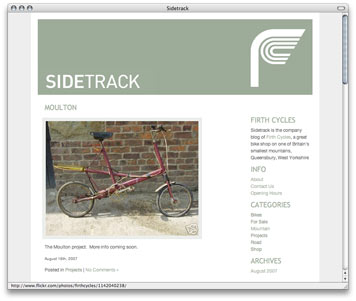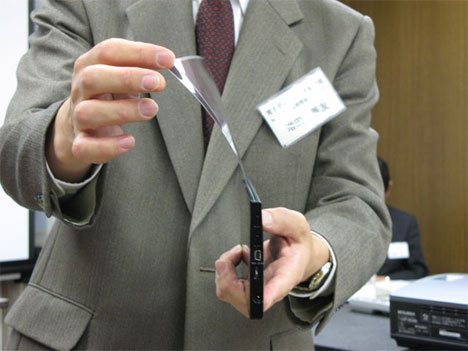
Wednesday, November 26, 2008
Disadvantages of E-paper in Organizations
New technology always comes with kinks and bugs that need to be worked out before that technology can live up to its potential. Some of the disadvantages with using E-paper will diminish with time and feedback R&D, other disadvantages are inherent to the specific technology. This distinction is an important one. We have already looked at the pros or E-paper, now we will discuss the potential cons.
E-paper is riding on the crest of the new technology wave and the expectations we hold of its capabilities are bound to be too high. E-paper is certainly doomed to not live up to at least some of these expectations including; display capabilities, durability, and longevity. These possible limitations are ones that are most likely to start disappear after its introduction to the market, but are ones the first buyers will likely face. (1)
The display capabilities of e-paper currently have several restrictions including: refresh rate, colour display, and zoom and scrolling options. (2) The low refresh rate or electronic paper means that pages load slow and can’t be quickly manipulated like when viewing a pdf document on your laptop. Instead, text and images take a few seconds to change which means limited or non-existent scrolling or zooming options. Colour is the other hurdle that e-paper technology has to overcome to be a viable alternative option to normal paper. Although some companies, including LG.Phillips have shown E-paper capable of displaying colour, that colour is nowhere near the quality of printed paper or computer screens in terms or clarity, vividness and the number of colour tones available.
Obstacles with durability and longevity also pose problems to E-paper sales. People need to be able to trust E-paper to reproduce crisp and clear images and text for years after the E-paper is initially purchased. Currently E-paper tends to develop problems with its display after too much manipulation, similar to “burned out” pixels on LCD screens.
One more disadvantage that E-paper shares with other technology is its lack of tangibility. Paper is paper, and will still be there for you to read for a long time short of something like a fire destroying it. With E-paper as with computers the pages are stored digitally on some sort of hard drive. Can people trust that their data will not be erased if someone accidentally steps on their E-reader? Or sets a magnet on top of it? The loss of data because of a computer crash is something anyone who has been alive in this country for the last ten years can relate to. Some companies have claimed to have produced E-paper as study as real paper, but the true test will be how consumers find the E-paper`s durability. (3)
There is no doubt that E-paper will be snatched up and bought by many hungry tech consumers hours after its mass introduction to the market. Indeed many people on the cutting edge of technology are already able to purchase E-paper units. However some of these limitations may prevent the masses from fully embracing Electronic Paper until they are addressed.
1) http://thefutureofthings.com/articles/1000/the-future-of-electronic-paper.html
2) http://en.wikipedia.org/wiki/Epaper#Disadvantages
3) http://www.eptsolutions.com/Db/ept/news/pdf/Sales_Leaflet.PDF
Advantages of E-paper in Organizations
We have talked about some of the ways Electronic Paper technology can eventually be used in our personal lives. Now we will look at how E-paper can be advantageously applied to a business environment.
One cost effective application for businesses is to replace regular paper with E-paper. This both saves money, as E-paper can be reused ad infinitum, and is more environmentally friendly because it doesn’t require huge amounts of trees be cut down for its production. (1,2)
Besides the cost saving benefit of using Electronic paper, its versatility and simplicity is likely to contribute to its induction into organizations. Instead of printing off 25 copies of a 10 page business report in the morning for your department meeting in the afternoon, the employees who attend the meeting will be able to upload the document to each employee's E-paper reader as they walk into the meeting room. Technology might even allow whoever is presenting the report to highlight, circle, and underscore words on a master e-reader and send those annotations in real-time to the other employees E-readers. (3)
The bottom line is that E-paper is a cost effective, environmentally friendly and more versatile option than regular paper. These advantages are sure to see E-paper succeed in the business and organizational environment.
1) http://www.gizmag.com/e-paper-benefits-environment/8441/
2) http://en.wikipedia.org/wiki/Epaper
3) http://www.treehugger.com/files/2008/10/epaper-research-will-bring-full-color-interactive-digital-newspapers.php
Tuesday, November 25, 2008
What Can We Expect?
As is common with new technology, it’s easy to imagine endless possibilities and uses for Electronic Paper. Books, newspapers, billboards, all replaced with a single sheet of e-paper. Instead of carrying heavy textbooks to school, students in ten years might only need to bring a pocket size sheet that serves not only as all their textbooks in school but a shopping list as they head home from class, a magazine for the bus ride, even bringing up to the minute news beamed down from the internet.
Other technology will surely be touched by this thin and flexible electronic tablet. Imagine a computer with no keboard or mousepad and thinner than a credit card! Maybe a computer that you can roll up and put in your pocket. These are the dreams and long term aspirations that companies developing Electronic Paper have set on their horizons for the future. (1)
Other projected uses range from digital photo frames to paper thin watches and even Clothing with digital displays to show maps, weather reports, and text messages.
When?
These dreams may seem grandoise and far away today, so to get some context for the near future we will look at what to expect within the next five years. In January of 2008 LG.Phillips showed off a prototype 14.3-inch E-Paper model with a 1280×800 resolution and a 16.7 million colour display.(2)
Even more Plastic Logic is aiming to introduce its E-reader to the market as early as the first quarter of 2009. Here you can get a glimpse into how the E-reader will function and what to expect. (3)
Plastic Logics E-reader featured on CNN
1) http://en.wikipedia.org/wiki/Epaper#Commercial_applications
2) http://www.engadget.com/2008/01/03/lg-philips-announces-14-3-inch-flexible-e-paper-display-for-ces/
3) http://www.plasticlogic.com/
What is Electronic Paper?
Just like the name suggests, e-paper is a new technology that aims to replace ordinary printing paper with an electronic screen. Companies like Sony, LG, and Samsung have been further developing this electronic version of paper after it was first introduced in 1970 at the
What makes E-paper more advanced than previous digital display technology is its versatility. E-paper is flexible, bendable and somewhat smash-proof just like real paper. Also, the e-paper reflects light off its surface to illuminate text and pictures, unlike the computer screen you are using right now which uses a backlight to illuminate the pixels on the screen. This means the screens use less energy and can be made paper thin and gives the e-paper a wider viewing angle than other digital display screens. (2)
Several companies have come up with different solutions to making e-paper a reality. One solution is electrophoretic frontplane. This technology may seem complicated but the concept is easy enough to comprehend with an example. To visualize what electrophoretic frontplane is, imagine millions and millions of tiny balls trapped between two planes of glass. There are two types of balls; one half is white and is positively charged and the other is black and has a negative charge. To make characters materialize on the screen electric currents are applied and depending on how the charge is applied either a white or black ball will appear in that space (1). This visualization is seen in figure 1
Figure 1: Electrophoretic Frontplane Diagram

1) http://thefutureofthings.com)/articles/1000/the-future-of-electronic-paper.html
2) http://en.wikipedia.org/wiki/Epaper
3) http://www.howstuffworks.com/e-ink.htm






